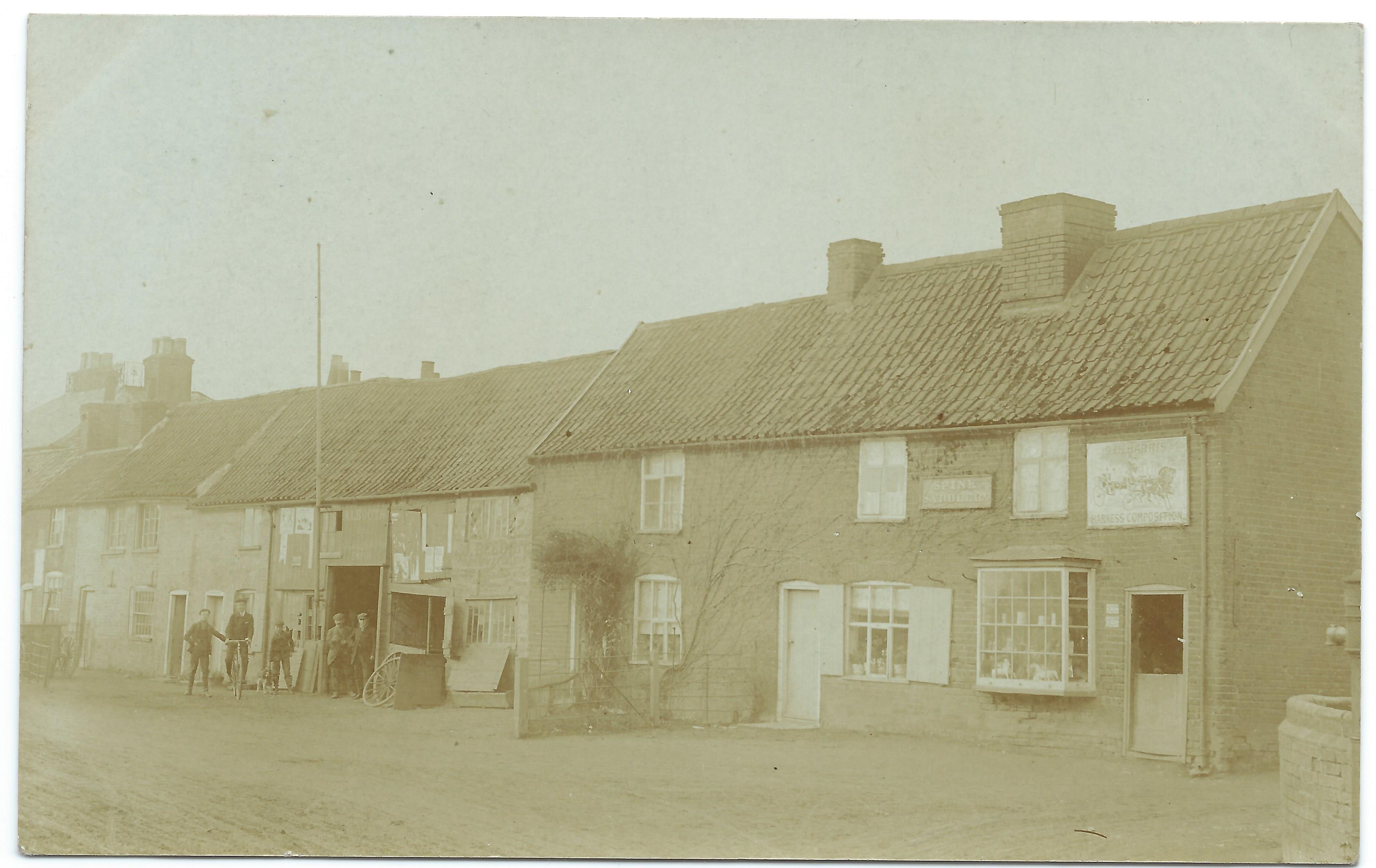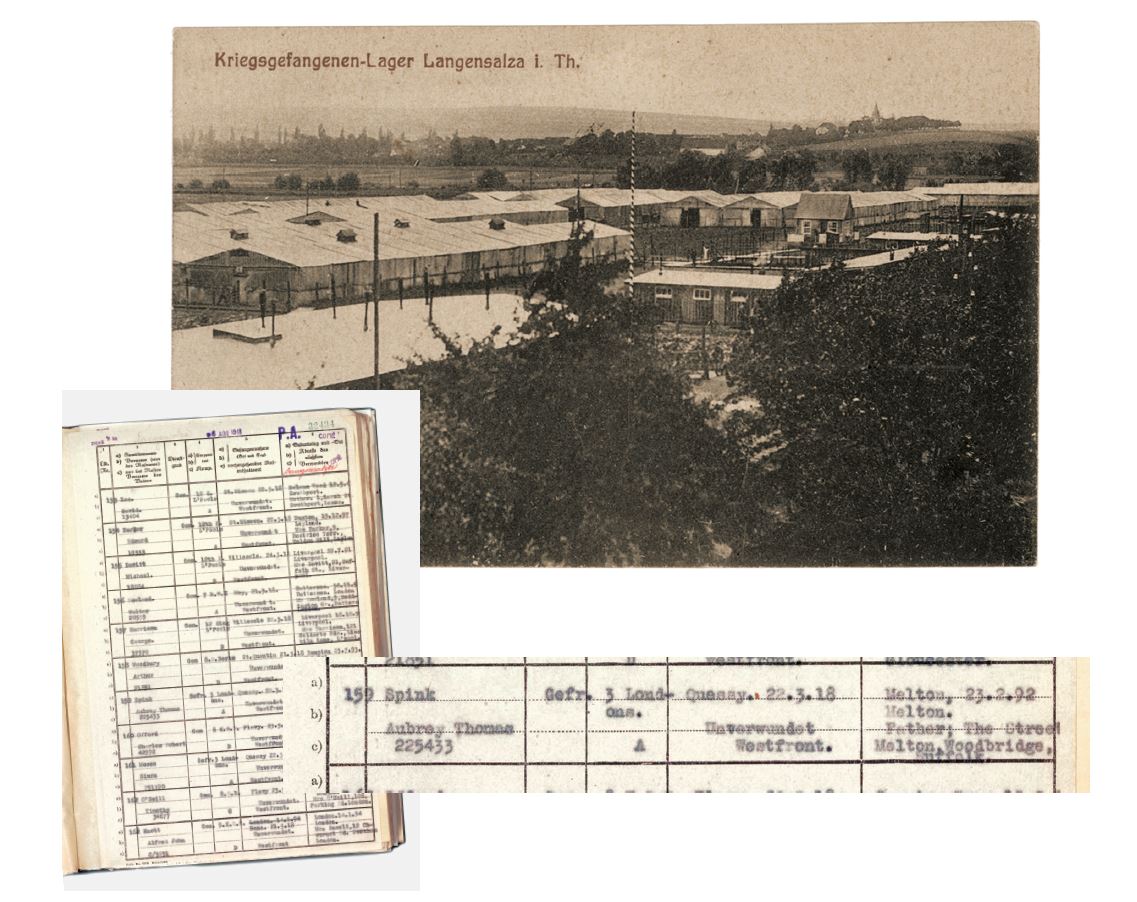Melton Street in around 1910: From right to left: Spink's Sadlery, Beaden's Wheelwright and Booth's Blacksmith
Aubrey was born on 23rd February 1893 and baptised at St Andrew's Church, Melton, on 4th June. His only sibling was Kathleen, who was born in 1886 and died late in the same year. Aubrey’s parents were Thomas and Jane; Thomas was a saddler and harnessmaker and ran the saddlery on the corner of The Street and Saddlemakers Lane, which he continued to do until he died in 1925. Jane died in 1908, when Aubrey was only eight years old. A year later, Thomas married Ellen Roberts. In 1911, Aubrey’s occupation was shown as being an office clerk at Page and Girling’s foundry on The Street. After Thomas Spink died in 1925, Ellen moved to Omega Cottage (now Rosemary Cottage on the Street). Thomas, Jane and Ellen are all buried at Melton Old Church.
In 1916, Aubrey was called up to enlist in the services. He initially joined the 3rd Battalion, Suffolk Regiment, and was mobilised on 3rd March. Three months later, after his basic training, Aubrey was posted to France where he joined the 24th (County of London) Battalion London Regiment. Aubrey was named in the daily casualty list published in the local newspaper in November 1916, but no further information is available to show why. He stayed with the 24th Battalion, London Regiment, until 9th August 1917 when he joined the 1/3rd (City Of London) London Regiment (Royal Fusiliers) who were based near Ypres.
On 16th August, the battalion took part in the Battle of Langemarck during the Third Battle of Ypres or “Passchendaele”. This was the only action they would see in this particular battle as, by the end of the month, they had been moved south to Baupaume in France. Here, Aubrey and his battalion were to take part in the Battle of Cambrai between 20th November and 7th December 1917.
At the end of January 1918, Aubrey's 1/3rd Battalion was amalgamated with the 2/3rd City Of London Battalion and was redesignated the 3rd (City of London) Battalion, Royal Fusiliers. For the first week of February, the battalion underwent training at Hailles near Amiens in France, and by the 8th February, the battalion was on the front line along the canal at Tergniers some twelve miles (twenty km) south of Saint-Quentin. The battalion was to remain in the area throughout February and March.
On 21st March, the German Army launched their spring offensive or Operation Michael in a final attempt to force the allies to the coast. The battalion war diary recorded the first days of the German advance. On 21st March, the battalion's strength was forty-seven Officers and nine hundred and nine men who had been providing working parties while in the Divisional Reserve. When the offensive began, they were moved to the front line at Tergniers and Fargniers in support of the 2/4th City of London Battalion, Royal Fusiliers. Over the next three days, the battalion was pushed back to Quierzy, some ten miles (sixteen km) away from Tergniers. The battalion's casualties over this period were eighteen Officers and three hundred and forty-one men. Aubrey was one of them; he was reported as missing in the War Office Daily List published on 17th May 1918 having been taken prisoner at Quessy on 23rd March.
By 24th June 1918, Aubrey was imprisoned at Wittenberg Prisoner of War camp in Saxony-Anhalt, eastern Germany. Six weeks later, he had been moved to Langensalza Camp in Thuringia, Germany. The Langensalza camp had the reputation of being one of the worst prisoner of war camps in Germany. For Aubrey, his time there cannot have been pleasant as these contemporary accounts by fellow prisoners in the camp show.
Corporal Frederick Golding of the 8th Battalion, Leicestershire Regiment, was captured in May 1918 and arrived at the camp in June. In an interview with the International Red Cross he described his arrival:
“We were first of all put into an isolation camp, but the accommodation was abominable. One thousand men were quartered in three overcrowded barrack huts, and we suffered great discomfort. After a fortnight they moved us into the main camp, where I remained during the whole time of my captivity.”
Another prisoner, Private George Mulford of the 12th York and Lancaster Regiment, wrote in his memoirs: "
Think of the conditions of 12,000 men huddled together on a large sized ploughed field so situated that it caught all the water draining from the surrounding hills. Sanitary arrangements on a par with those of the native quarter in an Egyptian town. Food of the vilest and unhealthiest nature for human consumption. Long ramshackle dilapidated barracks to hold 700 to 800 men with no thought in their construction for comfort and accommodation."
Aubrey was repatriated to Britain in early 1919. For his war service, he received the British War and Victory Medals. In 1926, Aubrey married Mildred Maud Brown in Essex. In 1939, Aubrey was working as a plastic and Bakelite moulder in Thurrock, Essex. He died in 1985 in the Greater London area.
Aubrey Spink was held prisoner at Langensalza camp which had the reputation of being one of the worst prisoner of war camps in Germany.
